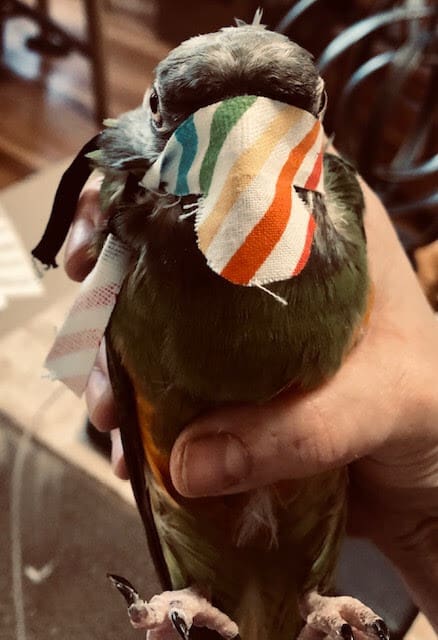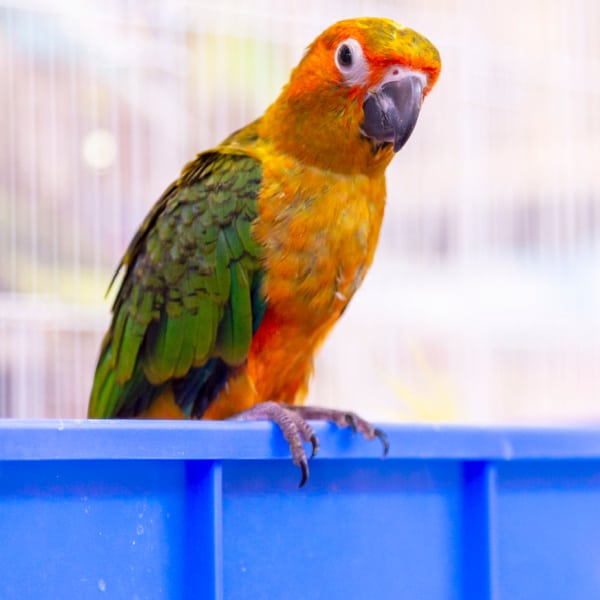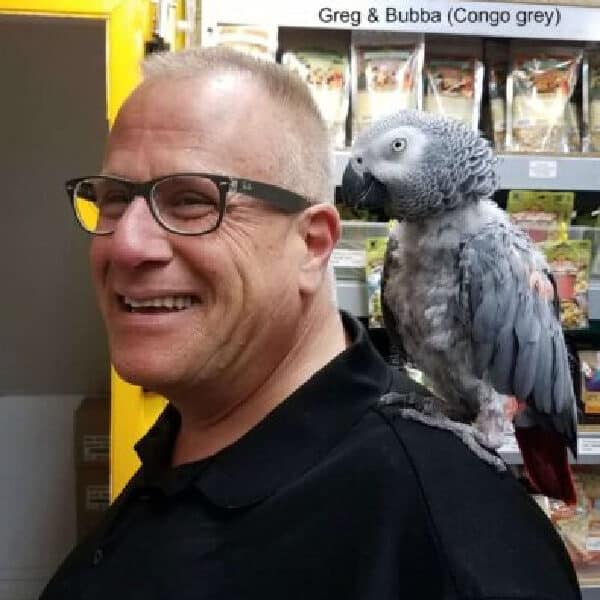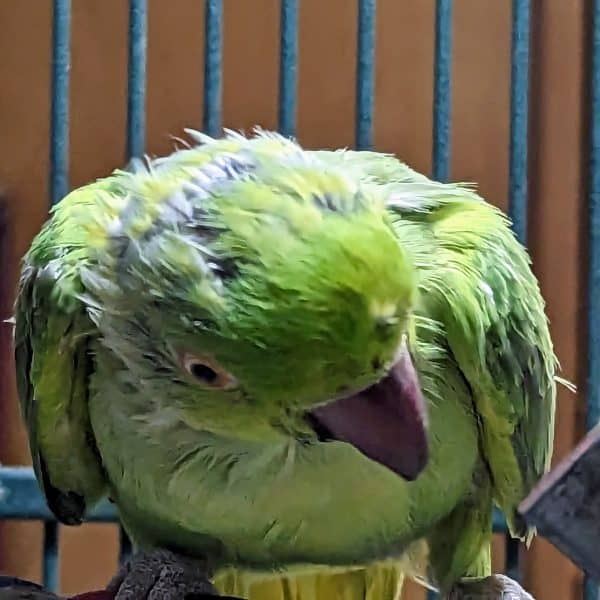
Why I Think My Birds Are Happy
Last Updated on by Mitch Rezman
Lynn H writes
Hi. First of all, thank you much for all of your valuable information.
It is greatly appreciated.
RE: Do You Think That Birds Are Unhappy in a Bird Cage?
I have had a total of three birds: a cockatiel, a quaker parakeet, and a Senegal parrot since 1990.
In response to your request, my view is that a bird will be happy in a cage as long as you provide him/her, with a happy and healthy environment for him.
That includes having a stimulating toy or toys inside and outside of the cage.
I also think that an important factor is for an owner to figure out how much time he has to spend with a bird when s/he first moves in.
If you spend hours and hours in the beginning and then they’re gone during the day for work in the future, they will understandably get upset.
So I set up a routine for the beginning with each bird.
I also made sure that they had enough to do during the day where they were not bored.
I believe that all three of my parrots were happy in their cages but I was very mindful to see what they liked and did not like.
It stands to reason that if they like their cage contains and are not bored, they are happy.
I also did my homework by thoroughly researching the species of each bird to learn their tendencies (Quaker/weaver), (Senegal/shredder) before getting them and before setting up their cages.
I also joined a website called “BirdClick” with Melinda Johnson and Wendy Jeffries (animal trainer).
I eventually became an admin on the site but had to pull out due to time constraints.
I also ghostwrote Melinda’s book on parrot training (published by Karen Pryor).
Melinda did thank me for editing in the intro but did not address how much I had written.
No worries though.
Do you think it is important for owners to find out what kind of a bird they are getting and what their preferences/tendencies are to determine which type of toys, etc., should be in the cage?
MitchR responds with “absolutely”!
Now onto the birds.
My cockatiel, Spunky, seemed to have no problem being in the cage and was allowed out of the cage under supervision.
Her issue was with toys.
She did not want new toys to be introduced. I think that she thought they would eat her.
I tried everything but none were accepted except for a plastic canary swing that had been left on the cage perch when I bought it.
The swing was for a much smaller bird. But she would spend her time dragging it back-and-forth on her perch and seemed very happy with it.
She always had a good personality.
My Quaker, Gizmo, was a weaver.
She literally anchored her swing by weaving pull-apart strings & toys to hold it in place and not move.
She had tons of toys and slept in a fleece hanging pup-tent. I also anchored toys and a boing (twisted stiff rope) on top of her cage.
I left the Disney Channel on during the day and at night, she had playtime with her friend Gonzo whom I’ll address in a minute.
She also liked having floor time where she learned how to place a ball into a mini basketball net, and place a ring on & off a post.
I trained her using positive operant conditioning and clicker training. She seemed happy in her cage. I would come home, open the cage door, and leave it open.
When I approached the cage, she would come out to play with me.
She always seemed like she was in a good mood.
Gizmo organized her cage and appeared to have a sleeping part and a playing part.
She did not mind when I introduced new toys or switched toys around.
She also taught herself to escape from her large cage so I wound up using a carabiner clip to secure it during the day.
Gonzo, my Senegal, was a bit different than the others.
Her moods varied so I had to look at her pupils and body language when working with her.
I did not train Gonzo from the beginning since I adopted her from my brother.
But she watched my clicker training with Gizmo.
She would have none of it but I was able to teach her a vocabulary which she would respond to my voice.
I still use the reward system but did not use a clicker with her.
Gonzo likes her cage.
She can be very territorial if I reach my hand inside of it.
I do not think she was treated well and my brother’s girlfriend who had taken care of her for a little while.
She might’ve grabbed her or abused her which was why she was extremely skittish when I first got her.
Gizmo was not like that beforehand, when my brother was raising her.
When I leave the cage door open, sometimes she goes out, and sometimes she doesn’t. It depends on what she wants to do.
I have taught her to say “wanna play” (meaning let me out of the cage).
She also does this when she wants me to pet her.
She often says “hi” and adds “wanna play” right afterward.
Sometimes she even says “OK” and a robotic voice as if I am agreeing with her.
In fact, as I am writing this email, Gonzo has been outside of her cage right next to where I am sitting, repeatedly saying “Hi, wanna play?” with different intonations.
I’ve been giving her scritches while typing with one finger on my iPhone to write this email.
So please pardon the typos.
She also does this when she wants me to pet her.
She knows the words “up up” and what they mean.
And if it’s time for bed, I say let’s go “night night” and she immediately hangs upside down in an angle to go to sleep.
I tried giving her a pup tent but she just used it for target practice so I removed it.
She also knows “get down.”
When Gonzo had a smaller cage, she would immediately climb down from the top of her cage to the inside.
Her new cage was much larger and awkward for her so I rigged it with rope chords.
It took a while for her to learn how to get down to the bottom of the cage.
Does the Plethora of Parrot Perches Produce Puzzlement? Learn Perches & Placement Now!
So now when I want her to go get down, I have to get her attention, and continuously say “get down, good girl!” Otherwise, she might get distracted.
I need to add a footnote here.
Many years ago (in 1987, I think) when I was an undergrad at Northwestern University, I took a course “Introduction to Ethnology.”
As I had heard that Irene Pepperberg was teaching it and hoped to meet the notorious Alex, her late African gray parrot, which I did.
The class turned out to be a joke as we watched movies about the birds and the bees.
When I met Alex, though, he was a delight, being built to recognize her holding up “2” fingers, or identifying an object as a “truck” which was “green” in color.
But he was kept in a lab with no toys in his cage.
I personally thought that this was incredibly sad, as did the other students.
I do not know what his home environment was like, although I did buy the DVD and was unimpressed it.
Professor Pepperberg and her daughter and someone else just chatted around the kitchen counter throughout the video.
I met Alex, he had been plucking his feathers.
Professor Pepperberg explained that he missed her when she traveled.
I’m not sure how he died but it was premature.
Maybe stress was a factor.
Well, those are my comments. Sorry for my rambling.
Feel free to reach out to me if you have any questions about what I wrote.
Written by Lynn H
Approved by Mitch Rezman & Catherine Tobsing
Note: I recall years back when I had a vendor table set up at an event where Irene Pepperberg was. She purchased one 2″ wooden ring for Alex. It was 25 cents. I recall sending her a bag of them for Alex but never heard back…Catherine
Author Profile
Latest entries
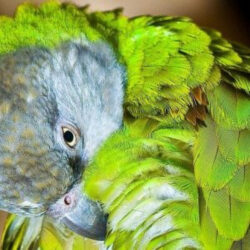 Bird & Parrot CareJanuary 10, 2020Why I Think My Birds Are Happy
Bird & Parrot CareJanuary 10, 2020Why I Think My Birds Are Happy
